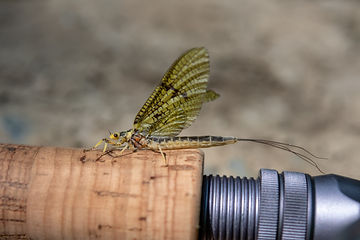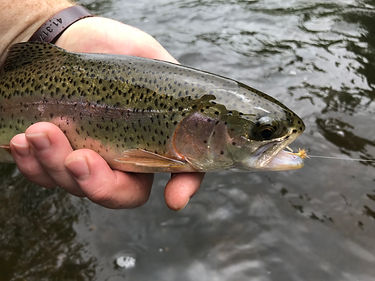Masking Hatches and Selective Trout

Masking hatches are “usually” a large fly that’s emerging about the same time as a smaller fly. The smaller fly is usually less obvious, and in fact, you may not even see it hatching at all, yet the trout seem to prefer it over the larger fly for one reason or another. I place the word usually in quotes because I’ve also seen where the small fly was the masking hatch and trout actually fed on the larger fly.
In May 2020, I was on Yellow Creek in Bedford County when a massive hatch of BWOs came off…and I do mean massive. Fish were up and feeding, but refused my imitation on every drift. As I sat on the bank rummaging through my fly box, I looked up and saw a lone Quill Gordon fluttering in the sunlight. So I tied on a Quill Gordon, size 14, and caught every trout rising in that pool.
Later, as I was sitting on the bank pondering what just went down, I noticed that the reason I saw hardly any Quill Gordons in the air was because the trout were hammering every single one as it came off.
Theories of Selectivity
Why fish prefer one species over another when a smorgasbord’s available is a mystery to me, which I don’t feel bad about since it has perplexed many great and knowledgeable fishermen before me and will likely continue to do so long after I am gone. But it’s okay to develop theories as to why fish become selective – just don’t mistake them for fact.
One of my theories is that it probably has to do with survival. A trout feeds selectively, focusing on the size, shape, and color of a particular insect so that it can better spot a phony from the real deal. This especially seems to be the case on heavily-pressured waters where trout do indeed see a lot of presentations – think Penn’s Creek, Spring Creek, and other classic Pennsylvania trout waters.
Toward the end of May, I was back on Yellow Creek as the Green Drakes were coming off. The hatch never really peaked as much as a few came off here and there all day long. There were always duns on the water, though, and every one of them sailed through the pools untouched.
“They just don’t come up for the drakes like they used to,” an older guy told me. “When I started fishing here in the early ‘90s, trout went nuts for the drakes. Now they don’t surface feed on them hardly at all.”
His theory was that the fishing pressure on that stream has caused the trout to avoid heavy surface feeding. I don’t doubt that pressure has increased over the years. Some days, you can barely find a place to fish along the whole, mile-long Fly Fishing Only section.
The guy may or may not be right, and it does sort of explain why trout seldom rise aggressively for Green Drakes. Like many streams known to harbor great fly hatches, Yellow Creek sees a drastic increase in traffic the last half of May, and it peaks around the time the drakes are expected to pop.

Perhaps as further proof, when drakes are on the water, but nothing is coming up for them, you can take trout pretty regularly all day long during a 10-day window on Green Drake nymphs or emergers. So they’re not ignoring the drakes entirely, just the adult stage of the insect. Also, trout seem to still rise well enough for Sulphurs, various caddis, and other smaller insects.
This helps explains why I’ve had more consistent experiences with rising trout during the early season hatches on Yellow Creek. Fishing pressure is usually considerably less. Plus, these hatches follow a prolonged time of sparse pressure (the winter months) rather than emerging during a month-long siege of non-stop traffic.
Again, these are just theories.
Weather Considerations
I think which species they prefer also has to do with how a fish is seeing insects that particular day, which can be affected by overcast skies, sunshine, rain, wind, etc. Several times, I’ve witnessed a wild brown selectively feeding on Sulphurs one evening and Light Cahills the next, even though both species were present on the water each time.
Even more frustrating is when multiple fish are rising in a stretch and each one is keying on a different species. More puzzling is when it appears that trout are selective based on their size class. On the Clarion River last June, I noticed numerous smaller trout targeting cream caddis while larger fish targeted something else – but more about that in a bit.
Weather can affect how insects emerge. For instance, surface tension can change according to temperature, barometric pressure, or various weather-related factors. Surface tension is best described as the water’s skin, somewhat similar to a piece of plastic wrap laid on top of the water. The thickness of that skin can change, which can impact how well insects break through the surface to emerge as adults.
In some cases, individual insects aren’t strong enough to push through the skin and get caught in the film. Even when the water is laced with adult duns, trout can target these crippled flies exclusively because they’re such an easy meal. In this instance, the adult duns serve as a sort of masking hatch for the crippled insects the trout are actually feeding on.
As a side note, surface tension decreases as temperatures rise. Considering that many mayflies, as well as caddis, tend to hatch on cool, dark, and dreary days when surface tension is higher, you can see why so many can become trapped in the film, especially larger species such as March Browns and Green Drakes. This is also why the majority of species emerge in the riffles where the water surface is broken and tension is lower. Simply stated, it’s easier for these species to emerge.
Back on the Clarion
Unless we die and are reincarnated as a trout, we will probably never know exactly why they prefer one insect over another on any particular day. I’ve heard some people say that each species of mayfly tastes different, with some more tasty than others and thus more desirable. Or maybe it’s just that every trout’s palette is different. Again, more theories.
The longer I watched trout feeding on the Clarion River that morning, the more clear it became that the smaller fish were taking a size 16 Cream Caddis. I tied on an Elk Hair version and caught several trout under 10 inches. They were all beautiful wild browns with the trademark black spot behind the eye. But while they readily took the caddis, the handful of bigger trout refused the presentation. In fact, the caddis didn’t get refused as much as it got ignored.
If the fly had simply gotten refused – as in, trout came up to eat it but upon closer inspection found it unsuitable – I’d have attributed to my lack of success on poor presentation. This was a long flat stretch. Water depth averaged around two feet and the surface was smooth and unbroken. Exactly the type of water that gives fishermen fits when trying to place a drag-free drift over wary trout.
I resorted to my usual tactic, which was to move well upstream of a rising trout and float the fly down to them fly-first to avoid lining the fish. No luck. I was ready to give up and accept the fact that some trout are selective to the point that they become almost uncatchable on surface flies. And then I happened to be looking in the exact spot where a big fish decided to rise. Whatever it took wasn’t visible to the naked eye, at least from that distance.
On a whim, I rummaged through my fly box for the smallest pattern I could find, a size 20 Pale Morning Dun (PMD). It was a logical choice considering there were a few Sulphurs in the air, despite this pattern being way under sized.
The Clarion River, as far as I know, doesn’t have a PMD hatch. But I was pleasantly surprised when a hefty brown came up to inspect my imitation on the first drift, refused it, turned and went after it again, this time violently sucking it in. After releasing that fish, a plump 15-incher, I started to suspect that all of the species clearly visible in the air and on the water were just masking the hatch of a much smaller insect that I couldn’t see.

I landed another brown and then hopped in the kayak and floated to another stretch downriver where more trout were rising. It was the same basic scenario going on there, too. I caught several small trout on the caddis, switched to the size 20 PMD and immediately landed a fat rainbow. Meanwhile, the small trout totally ignored the PMD. The situation had me baffled. It made no sense, but these mysteries are easier to accept as long as you’re catching fish.
At the next spot downriver, I swung the kayak into a narrow spot between some rocks and shore. As I was climbing out, I noticed several bugs on the moss-covered rocks. There were Cream Caddis, of course, and a scattering of BWOs. But there was another fly, at first glance identical in color to the Cream Caddis, but upon closer inspection had whitish/light-colored wings and a golden yellow body. It was roughly size 20 and without a doubt a stonefly. If I didn’t know better, I’d say it was a Yellow Sally, although I’d never seen one quite this tiny.
So there you have it. My whim to try the smallest dry fly in my box was actually a very close match to the insects the big trout were feeding on. Pure luck on my part, but it made for a memorable day on the water.
A Good Detective
Matching the hatch is a science, a process. You can get lucky, like I did on the Clarion River, but figuring out what the fish are feeding on is a matter of gathering clues, taking external factors into consideration, and then putting those pieces together. And sometimes there are so many pieces. Not only do you have to figure out which species the trout are eating, but also which life cycle stage and how to best present it.
Truth is, sometimes you may never figure out exactly what a trout is keying on. For instance, that morning on the Clarion River I used a small seine to gather bugs on the surface yet found not a single Yellow Sally (if that’s indeed what they were). Similarly, in the instance of the massive hatch of BWOs on Yellow Creek a month earlier, there was no evidence of Quill Gordons until I spotted that single dun lifting up into the sky.
These are the toughest hatches to match, the ones that are so sparse as to appear nonexistent. The reason you don’t see them is because practically every natural is being gobbled up by fish. To further complicate matters, other species come off in more substantial numbers to mask their presence.
One of the biggest clues I’ve found that indicate this is happening is by noting the frequency with which the trout rises. Sporadic rises generally happen for a reason, the main one being the availability (or lack thereof) of preferred insects. Meanwhile, numerous individuals of another species, a masking hatch, can float by untouched.
And if all of that isn’t complicated enough, you also have to allow for the unexpected. Just because a certain species or size of mayfly or other insect isn’t listed on any of the hatch charts for a body of water doesn’t mean they’re not there. They may not appear often enough or in significant numbers to warrant being listed.
So it seems there can be a bit of guessing in matching the hatch after all. But isn’t that what good detectives do? They gather information and sometimes follow a hunch even if it makes no sense. Heck, even when it does seem obvious what the trout are taking, I still wouldn’t bet the house on it.
Sign up for the Dark Skies Fly Fishing e-newsletter
It's free, delivered to your inbox approximately three times each month. Your information is always kept private and used for the sole purpose of keeping you up to date on blog posts and specials in the online store.
Sign Up Now
